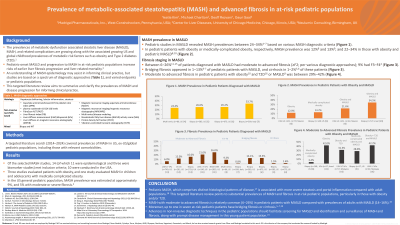Monday Poster Session
Category: Liver
P2876 - Prevalence of Metabolic-Associated Steatohepatitis (MASH) and Advanced Fibrosis in At-Risk Pediatric Populations
Monday, October 28, 2024
10:30 AM - 4:00 PM ET
Location: Exhibit Hall E

Has Audio
- YK
Yestle Kim, PharmD, MS
Madrigal Pharmaceuticals
Conshohocken, PA
Presenting Author(s)
Yestle Kim, PharmD, MS1, Michael Charlton, MBBS2, Geoff Rezvani, MD1, Gauri B. Saal, MA3
1Madrigal Pharmaceuticals, Conshohocken, PA; 2University of Chicago Medicine, Chicago, IL; 3Neulumic Consulting, Solihull, England, United Kingdom
Introduction: Existing epidemiological evidence points to the significant and growing prevalence of metabolic-associated steatotic liver disease (MASLD) in US and global pediatric populations, currently between 7–27% and forecasted to grow to 31% overall by 2040 with increasing prevalences of associated risk factors. As early-onset MASLD and progression to MASH increase risks of earlier fibrosis and mortality, an understanding of the current epidemiology of MASLD/MASH disease progression is warranted to inform pediatric clinical practice.
Methods: Targeted and secondary literature searches (2014–2024) covered prevalences of MASH and sequelae in US, ex-US/global pediatric populations (≤18 years of age).
Results: Fourteen studies (eleven epidemiological and three biomarker) met the inclusion criteria, of which ten originated from the US (Table). Three studies evaluated patients with obesity, and one in medically-complicated obesity. Overall, MASH prevalence ranged between 8.7–33.7%. In a general pediatric population, MASH prevalence was 8.7% and fibrosis ≥F2 ranged between 0.2–5.8%. In pediatric subpopulations with MASLD, MASH prevalence ranged between 24.4–34.5%. In pediatric candidates for bariatric surgery, overall and with MASLD, respectively, MASH prevalence was 13.2% / 34.5%; with fibrosis F1-F2 in 6.9% / 18.0%; and fibrosis F3 in 0.6% / 1.7%. In pediatric populations with obesity and diabetes (overall and with MASLD, respectively), fibrosis rates for F2 were: 17.5% / 22.7% and for F3 were: 7.0% / 9.1%. Fibrosis prevalence in MASLD, as based on various classifications, showed rates between 26.0-42.0% for at least moderate (≥F2) fibrosis, and up to 1.2–9.3% for advanced fibrosis consistent with F4. Bridging fibrosis or cirrhosis, respectively, appeared in 0.8–13.3% and 1.5–1.6% of pediatric patients with MASLD.
Discussion: The literature points to substantial prevalence rates of MASH and fibrosis in pediatric populations, particularly in sub-populations with medically-complicated obesity. Pediatric MASH represents a distinct histological pattern of disease, with steatosis and portal inflammation more severe compared with adult populations; and fibrosis severity is considered the most important predictor of long-term pediatric disease progression and mortality. As the non-invasive diagnostic techniques in the pediatric populations become more established, surveillance of MASH and fibrosis along with prompt disease management in this young patient population will be more feasible and critical.
Note: The table for this abstract can be viewed in the ePoster Gallery section of the ACG 2024 ePoster Site or in The American Journal of Gastroenterology's abstract supplement issue, both of which will be available starting October 27, 2024.
Disclosures:
Yestle Kim, PharmD, MS1, Michael Charlton, MBBS2, Geoff Rezvani, MD1, Gauri B. Saal, MA3. P2876 - Prevalence of Metabolic-Associated Steatohepatitis (MASH) and Advanced Fibrosis in At-Risk Pediatric Populations, ACG 2024 Annual Scientific Meeting Abstracts. Philadelphia, PA: American College of Gastroenterology.
1Madrigal Pharmaceuticals, Conshohocken, PA; 2University of Chicago Medicine, Chicago, IL; 3Neulumic Consulting, Solihull, England, United Kingdom
Introduction: Existing epidemiological evidence points to the significant and growing prevalence of metabolic-associated steatotic liver disease (MASLD) in US and global pediatric populations, currently between 7–27% and forecasted to grow to 31% overall by 2040 with increasing prevalences of associated risk factors. As early-onset MASLD and progression to MASH increase risks of earlier fibrosis and mortality, an understanding of the current epidemiology of MASLD/MASH disease progression is warranted to inform pediatric clinical practice.
Methods: Targeted and secondary literature searches (2014–2024) covered prevalences of MASH and sequelae in US, ex-US/global pediatric populations (≤18 years of age).
Results: Fourteen studies (eleven epidemiological and three biomarker) met the inclusion criteria, of which ten originated from the US (Table). Three studies evaluated patients with obesity, and one in medically-complicated obesity. Overall, MASH prevalence ranged between 8.7–33.7%. In a general pediatric population, MASH prevalence was 8.7% and fibrosis ≥F2 ranged between 0.2–5.8%. In pediatric subpopulations with MASLD, MASH prevalence ranged between 24.4–34.5%. In pediatric candidates for bariatric surgery, overall and with MASLD, respectively, MASH prevalence was 13.2% / 34.5%; with fibrosis F1-F2 in 6.9% / 18.0%; and fibrosis F3 in 0.6% / 1.7%. In pediatric populations with obesity and diabetes (overall and with MASLD, respectively), fibrosis rates for F2 were: 17.5% / 22.7% and for F3 were: 7.0% / 9.1%. Fibrosis prevalence in MASLD, as based on various classifications, showed rates between 26.0-42.0% for at least moderate (≥F2) fibrosis, and up to 1.2–9.3% for advanced fibrosis consistent with F4. Bridging fibrosis or cirrhosis, respectively, appeared in 0.8–13.3% and 1.5–1.6% of pediatric patients with MASLD.
Discussion: The literature points to substantial prevalence rates of MASH and fibrosis in pediatric populations, particularly in sub-populations with medically-complicated obesity. Pediatric MASH represents a distinct histological pattern of disease, with steatosis and portal inflammation more severe compared with adult populations; and fibrosis severity is considered the most important predictor of long-term pediatric disease progression and mortality. As the non-invasive diagnostic techniques in the pediatric populations become more established, surveillance of MASH and fibrosis along with prompt disease management in this young patient population will be more feasible and critical.
Note: The table for this abstract can be viewed in the ePoster Gallery section of the ACG 2024 ePoster Site or in The American Journal of Gastroenterology's abstract supplement issue, both of which will be available starting October 27, 2024.
Disclosures:
Yestle Kim: Madrigal – Employee.
Michael Charlton: Madrigal Pharmaceuticals, Inc., Novo Nordisk, Cytodyn, Terns, Alnylam, AMR, Glympse, Northsea, Sagmimet, Genentech, Merck, Pfizer – Advisory Committee/Board Member, Consultant, Grant/Research Support.
Geoff Rezvani: Madrigal Pharmaceuticals – Employee. Moderna – Employee.
Gauri Saal: Madrigal Pharmaceuticals, Inc. – Consultant.
Yestle Kim, PharmD, MS1, Michael Charlton, MBBS2, Geoff Rezvani, MD1, Gauri B. Saal, MA3. P2876 - Prevalence of Metabolic-Associated Steatohepatitis (MASH) and Advanced Fibrosis in At-Risk Pediatric Populations, ACG 2024 Annual Scientific Meeting Abstracts. Philadelphia, PA: American College of Gastroenterology.
